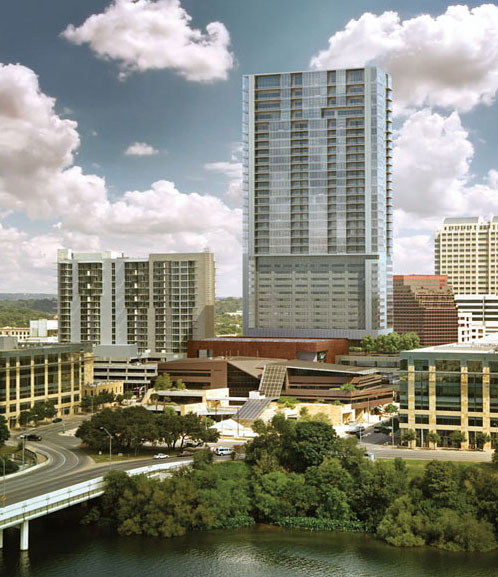Transparency: Literal and Sustainable
Transparency and technology
The Modernist obsession with glass put pressure on industry to improve the material's performance. One of the first responses was the bronze, titanium, and gold mirror glasses developed in the 1960s and '70s. Mirror glass is great in terms of reducing solar loads, with an SHGC in the 0.20 to 0.30 range or lower, but awful for daylighting, with a VLT often less than 10 percent. In the 1980s, low-E coatings were introduced to reduce reflectivity and improve VLT while still controlling the SHGC. These coatings have evolved to the point where, as with the Cleveland Clinic, an architect can specify glass with a VLT in the 40 to 50 percent range without significantly increasing solar heat gain.
Only a short time ago, glass with a VLT greater than 40 percent had a minimum SHGC of 0.40. But over the past decade, manufacturers have been able to reduce the SHGC first to 0.35, and then down to 0.30. These numbers correspond to glasses that appear clear, as opposed to green, gray, or blue/green. Low-iron glass typically has less of a greenish tint than float glass.
Many manufacturers also produce fritted glazing. This type of glass includes a silk-screened ceramic pattern that helps reduce glare and the SHGC, even if only by a small amount. Although frit is not new, architects are finding new ways to use it, such as in Gehry Partners' frosted white InterActiveCorp building, not far from the Chelsea Modern, on New York City's west side [Architectural Record, October 2007, page 114].
 |
The cladding strategy for Block 21, a hotel and condominium project under construction in Austin, Texas, includes a glass and aluminum curtain wall with large spandrel panels for the building's lower floors. The tower's upper levels have larger expanses of clear glass balanced with areas of higher reflectivity glass. Images courtesy Andersson Wise Architects and BOKA Powell |
Â

Â
Another option is electrochromic glazing, otherwise known as switchable glass. Dane Sanders, an engineer with Boulder, Colorado−based daylighting consultant Clanton and Associates, originally proposed electrochromic glazing for Block 21, a 35-story hotel and condominium project under construction in Austin, Texas. The glass appears clear, but becomes darker when exposed to sun, reducing VLT but improving thermal performance by as much as 80 percent. But "it's expensive, and it's another thing you have to supply with electricity," says Sanders, which perhaps explains why it is not part of the building's final design. Instead, the Block 21 project team, which includes Andersson Wise Architects and BOKA Powell as architect of record, focused on reducing east and west exposures, introducing a more conventional glass-and-aluminum curtain wall with large spandrels for the hotel. Then, for the condominium portion at the top of the tower, the designers chose larger expanses of recessed, clearer glass balanced with areas of higher reflectivity glass. The overall effect is glassy, but the variety of constructions should ensure a high enough level of performance to help the project achieve its LEED Platinum goal.
Architecture by numbers
Building designers now have largely invisible methods for dealing with environmental conditions that were only intuitively understood by the early Modernists. And glass and coatings manufacturers have quantitative methods for describing product performance. They feed the numerical specifications of their products into the International Glazing Database, which itself is embedded in the Optics 5 and Window 6 software developed by the Lawrence Berkeley National Laboratory (both free at http://windows.lbl.gov). Optics 5 allows designers to build their own glass type, specifying nearly every property, which then can be used to assemble a complete glazed unit-frame and all-in Window 6. These programs give designers precise performance data to feed directly into modeling software such as EnergyPlus or Radiance. In theory, any glass type is possible. Ubbelohde says L+U has often created an ideal glass and then asked a manufacturer to make it. "We're not bound by what's in Window 6," she says. "It's only the laws of physics holding us back." Le Corbusier's original Cité de Refuge may not have been entirely possible in the 1930s, but he imagined it anyway.








